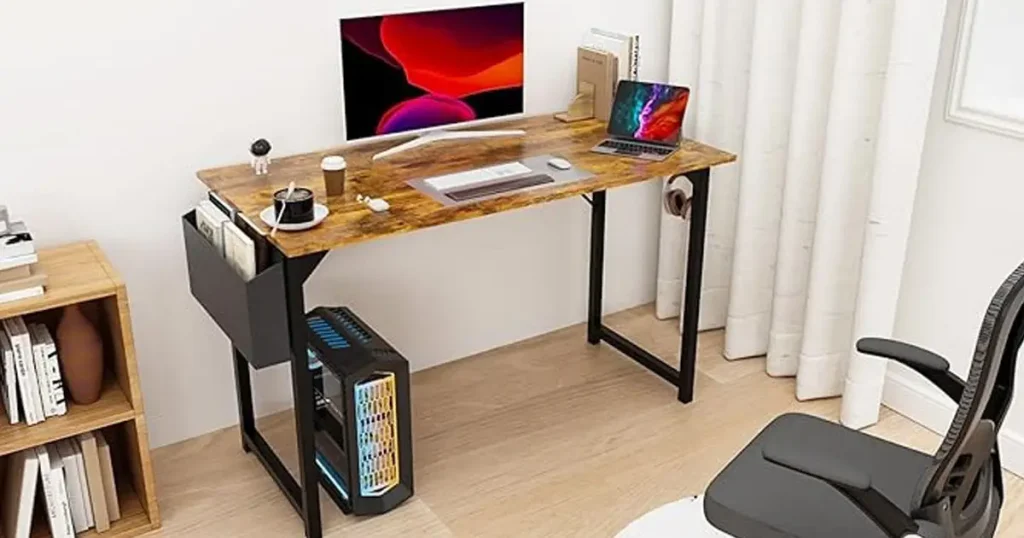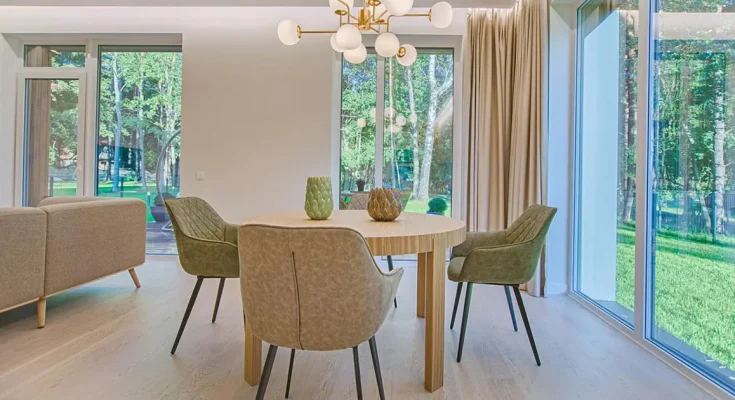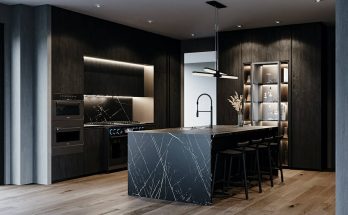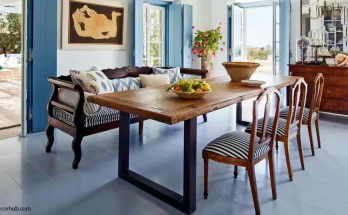Dining tables and desks typically differ in height. While dining tables usually stand at about 30 inches, desks may vary from 28 to 30 inches.
Furniture is one of the most important elements of design that greatly depends on concrete material, forms, and colors when working on effective and comfortable interior solutions. Dining tables are essential parts of houses where the family sits together to have meals and also entertain their guests and are usually constructed with standard heights to contain dining chairs and their usage by people.
Meanwhile, desks serve as personal workstations where ergonomics play a crucial role. Slight variations in desk height cater to different task requirements and individual user comfort. Selecting the appropriate furniture height impacts posture, convenience, and the overall aesthetic of a room. It is crucial to grasp such distinctions to create a comfortable home office space or an adorable dining area; that will allow one to buy and use the proper furniture suitable for achieving the optimal result.
Table of Contents
Unveiling The Mysteries Of Dining Tables And Desks
In Unveiling the Mysteries of Dining Tables and Desks, we are taken through a chronological tour and design history. These statement pieces serve not just functional needs but also reflect historical evolution. Their heights may seem similar, yet they hint at distinct eras and usages.
Tales Of Tables: Origin And Design
Bold traces of history lie in the design of tables. Crafted for stability and refined over centuries, dining tables were once symbols of communal gathering. They stand typically at 28 to 30 inches tall, a height fine-tuned for comfort during meal times.
| Type of Table | Standard Height | Primary Use |
| Dining Table | 28-30 inches | Meals and Gatherings |
| Desk | 28-30 inches | Work and Study |
- Round tables – social and intimate.
- Square tables – functional and space-efficient.
- Rectangular tables – classic and spacious.
From Writing To Dining: The Evolution Of Desk Uses
Once the realm of scholars, desks have evolved. They now serve multiple purposes in modern homes, facing new expectations. The standard desk height mirrors that of dining tables, poised at 28 to 30 inches.
- Writing desks gave way to computer desks.
- Desks transformed from solely writing surfaces to multifunctional workstations.
- Modern desks accommodate technology, crafting, and gaming.
Height Matters: Dining Tables Vs. Desks
Height Matters: Dining Tables vs. Desks – a fundamental aspect often overlooked when selecting furniture for your home or office. Both serve a unique function. But is the height of a dining table the same as a desk’s? Comfort and functionality hinge on these differences.
The Standard Heights: A Comparison
Determining the correct furniture height can make or break your comfort level. Here’s a quick look at the typical dimensions:
| Furniture Type | Average Height (inches) |
| Dining Table | 28-30 |
| Desk | 28-30 |
Although similar in numbers, the usage context does warrant subtle variations.
Why Height Differences Are Crucial
Nuanced design differences exist between dining tables and desks for a reason.
- Posture and Comfort: Desk heights usually accommodate extended use. They account for the clearance needed for knees, thighs, and arms during long-term seating.
- Task-Specific Design: A desk might include additional components like keyboard trays. These modify the effective use of height and comfort.
- Chair Pairings: Dining chairs and office chairs differ in height. This factor determines the ideal height of the table or desk they pair with.
Functionality dictates form. The optimal height for a desk or dining table largely depends on its intended daily use and the corresponding ergonomics.
Ergonomics In Focus: Design Intent
Understanding that design shapes our daily life brings us to the heart of furniture ergonomics. Dining tables and desks serve different purposes. This insight influences their design. Shifting the focus to ergonomics reveals that design intent is more than aesthetic. It ensures furniture caters to comfort and functionality.
Comfort And Posture: Ergonomic Considerations
The right height of tables affects our posture. Ergonomic design minimizes strain. Desks and dining tables have unique height standards for this reason. A comfortable desk height ranges from 28 to 30 inches. This suits the average person while seated. Dining tables often share this height range. Yet, personal comfort can lead to variations.
- Desks cater to long work sessions.
- Dining tables are for eating and socializing.
- Ergonomic chairs complement these tables.
Dining chairs and office chairs differ in design too. Desk chairs often offer more adjustments. They match desk heights and support various body types. This attention to detail is what makes an ergonomically designed space.
Fitting Form With Function: How to Use Influences Design
Design shapes how we interact with furniture. Designers think about table use. A writing desk might have a lower height. This is to suit forearm alignment while writing. Computer desks are higher. They provide space for keyboards and mouse use. Dining tables accommodate dinnerware and elbow space.
| Table Type | Typical Height | Usage |
| Writing Desk | 28-30 inches | Writing by hand |
| Computer Desk | 28-30 inches | Keyboard and mouse use |
| Dining Table | 28-30 inches | Eating and socializing |
Furniture height impacts function and comfort. Adjustable desks offer flexibility. Users can change the height to fit various tasks. This functional approach caters to diverse needs. Ergonomic designs prioritize user well-being. They combine form and function seamlessly.
Versatile Spaces: Dual-purpose Furniture Trends
People nowadays are cramped for space, which is why their homes are designed in such a way to allow for as much usable space as possible. People must have multi-purpose furniture now. Individuals are beginning to incorporate creative approaches so as to get the most out of their living spaces. Multi-function articles set the pace in this trend-setting tradition. Tables and desks used for dining and working are no longer mere pieces of furniture. If used, they perform multiple tasks without compromising their elegance or utility.
The Rise Of Convertible Furniture
This type of furniture has been trending gradually. These pieces can easily transform spaces as they are used for various purposes. Below are the key benefits:
- Flexibility: Shift from work to dine in seconds.
- Cost-Efficient: Invest in one piece rather than two.
- Style-Savvy: Choose from chic designs that fit any decor.
Space-saving Solutions: When One Table Does It All
Dining tables and desks don’t always match in height. Yet, new designs are changing this. The focus now is on tables that adapt to various tasks. Here are standout features:
| Feature | Description |
| Adjustable Heights | Suitable for office work or a dinner party. |
| Built-in Storage | Keep essentials tucked away neatly. |
| Easy Transformation | Switch function with minimal effort. |
Such tables craft versatile environments. They encourage seamless transitions between activities. Live life with simplicity and ease.
Measuring Up: Diy Desk And Dining Table Projects
When embarking on DIY desk and dining table projects, understanding the optimal heights for each is crucial. Not all tables are the same and ergonomics can significantly help or hinder use as well as dining comfort. If the right approach is taken anyone can design furniture that fulfills not only aesthetic purposes but is functional for the people who will be using it every day.
Crafting To Correct Heights
Dining tables typically stand at 28 to 30 inches tall.
Desks, on the other hand, hover around 28 to 30 inches.
To determine the ideal height for your project, consider the chair height and user comfort. Use a tape measure to calculate the distance from the floor to the user’s hands when they are seated comfortably. Adjust your table or desk height to complement this measurement, ensuring plenty of knee clearance.
Material Matters: Ensuring Stability And Durability
Selecting the right materials is vital for the longevity of your tables. Hardwoods like oak or maple promise durability. Materials like steel or aluminum can be used for a solid base and still are representative of the modernist style.
- Plywood: Affordable and versatile, great for first-time projects.
- Solid Wood: Classic and durable, perfect for heirloom pieces.
- Metal: Provides industrial strength, offering a sleek finish.
The following materials guarantee that the tables will last for quite a long time. Remember to treat wooden surfaces and protect metals from corrosion. Proper care keeps your DIY furniture stable, durable, and beautiful for years to come.
Interior Styles: Matching Tables To Room Aesthetics
Furniture height is a feature that is rarely given much consideration. But it is significant in the specification of interior design. It is important to understand that dining tables and desks are not used for the same purpose. Should the woman be of the same height as the man? Now let’s examine how choosing the right table height can benefit your room in terms of looks and usability.
Harmonious Designs: Choosing The Right Height
The quest for the perfect table goes beyond color and style. The height plays a pivotal role in creating an inviting and comfortable space. Here are key points to consider for a harmonious design:
- Standard dining table height ranges from 28 to 30 inches.
- Desks might be slightly higher, usually between 28 and 30 inches.
- Ensure adequate legroom—about 12 inches from the seat of a chair.
Choose a table that complements the chair height. The table should align with the armrests for ease of use.
Aesthetic Impact Of Table Heights
Table height alters room dynamics. It can create a sense of openness or coziness. Consider these aspects for optimal aesthetic impact:
- Lower tables render a more casual, laid-back feel.
- Taller tables can add an element of formality and sophistication.
- Consistent table heights can tie a space together visually.
- Varying heights should be intentional for contrast and interest.
The right table height impacts functionality and style. It explains the way people go about their activities in the environment that is around them.
Custom Creations: Personalizing Table Heights
Custom Creations: Personalizing Table Heights embarks on a journey to blend functionality with style. Traditional dining tables and desks do not share the same height. This discrepancy prompts many to seek tables that fit their individual needs. Crafting a custom table offers a tailored solution.
The Art Of Custom Table Making
The art of table-making involves more than just aesthetics. Makers consider several factors:
- Intended Use: Determines overall design and height.
- Material Selection: Influences both the look and durability.
- Size and Shape: Dictates the table’s functionality and flow within a space.
Custom tables are unique. They reflect personal taste, room layout, and specific height requirements.
Personal Ergonomics: Finding Your Ideal Height
To find your ideal table height:
- Measure the distance from the floor to your elbow when seated.
- Consider the seat height of your chairs or preferences when standing.
- Select a height that allows for comfortable arm placement and minimal strain.
Personalizing your desk or dining table height enhances comfort and productivity. A table that fits you reduces discomfort and improves overall use.

Cultural Variations: Global Table Height Differences
The fascinating world of dining and workspaces reveals a tapestry of design decisions sculpted by culture. Table height differences globally underscore the diversity in dining customs and ergonomic preferences.
Dining Customs And Furniture Design
Dining tables and desks span a spectrum of sizes shaped by tradition. Here’s how cultural nuances influence furniture design:
- East Asia: Often features lower tables to complement floor seating.
- Western Europe: Prefers higher tables suited for chair seating.
- Middle East: Mixes both styles, reflecting diverse eating habits.
International Standards: Is There A Universal Height?
Is there a one-size-fits-all measurement for tables worldwide? Not quite. While industry guidelines suggest some common ground, no universal standard prevails. Here’s a breakdown of typical table heights:
| Region | Dining Table Height (cm) | Desk Height (cm) |
| North America | 76 | 74 |
| Europe | 75 | 74 |
| Asia | 70-75 | 70-75 |
Industry Insights: Furniture Manufacturing Norms
Understanding the furniture industry involves looking at how manufacturers design pieces. Furniture norms dictate a lot about usability and functionality. Specifically, with desks and dining tables, standards ensure they fit into our lives seamlessly.
The Role Of Mass Production
Mass production shapes furniture design. Factories produce large quantities, keeping costs down. This process requires set standards so each item fits with others. For desk and dining table heights, manufacturers often refer to ergonomic data to determine the best measurements for most users.
Here’s what the standards say about the furniture:
| Furniture Type | Standard Height (inches) |
| Dining Table | 28-30 |
| Desk | 28-30 |
Desks and dining tables often share similar height ranges to accommodate seated users.
Meeting The Needs: Adjustable And Standardized Heights
To serve different needs, the industry offers solutions. Adjustable desks cater to standing or sitting. Regular dining tables maintain a fixed height.
- Adjustable Desks:
- Personal comfort
- Height variation
- Health benefits
- Standard Dining Tables:
- Stable height
- Uniform look
- Suited for dining chairs
These options reflect manufacturers’ responses to diverse consumer preferences. Thus, furniture design becomes a blend of industry standards and flexibility.
Consumer Choices: Selecting The Right Table
Tables serve as the heart of many activities in our homes and offices. Picking the right one can elevate comfort and functionality. But are dining tables and desks the same height? Knowing the answer helps in making a wise pick for your space.
Assessing Your Space And Needs
Consider your room size and purpose. Measure your area to find a table that fits. Consider how you will utilize it. Will it host family dinners, or be your workstation?
- Large spaces can handle bigger tables.
- Small rooms may need compact or multi-use designs.
Height As A Deciding Factor In Table Selection
Comfort and function connect with table height. Dining tables and desks do differ in height. This difference affects your seating and posture. Below is a guide to standard heights:
| Type of Table | Standard Height |
| Dining Table | 28-30 inches |
| Desk | 29-30 inches |
Choose adjustable options for tailor-made comfort. Ergonomic chairs pair well with any table height. Always try before you buy to feel the difference.
Children And Tables: Height Considerations For Young Users
When it comes to furnishing a space for children, it’s crucial to consider their unique needs. Unlike adults, children require furniture that matches their size and flexibility to accommodate their growth. It raises an interesting question: Is the height of a dining table and a desk appropriate for a child’s usage? This is a crucial consideration because selecting the appropriate table is related to a child’s comfort, positioning, and ease of access.
Designing For Growth: Adaptable Furniture For Kids
Furniture that grows with your child is not only cost-effective; it is a smart choice for development. Adaptable furniture offers multiple settings that adjust for children’s rapidly changing height. Check out some considerations for adaptable furniture:
- Adjustable legs: These allow tables and desks to rise as your child grows.
- Tilting desktops: They offer different angles for reading, writing, or drawing.
- Convertible designs: Pieces that transform for various age groups.
Here’s an example of a table with adaptable features:
| Feature | Benefit |
| Height-adjustable | Matches the child’s growth |
| Multifunctional surface | For eating, studying, and playing |
| Durable material | Withstands wear and tear |
Safety And Accessibility In Youth Furniture
Safety should be a top priority when selecting tables for young users. A suitable table height minimizes risks and ensures easy access. Highlighting a few safety features:
- Rounded corners: They protect from sharp edges.
- Stable construction: Prevents tipping over.
- Proper height: Allows feet to rest flat on the floor.
Choose desks and tables that meet these criteria to foster a secure and kid-friendly environment. This makes the kids comfortable with their environment so that they can learn and even grow up healthy.
Looking Ahead: The Future Of Table Design
The very essence of furniture functionality is evolving. Dining tables and desks are not always the same height, but what if they could adapt to our needs? It is hoped that the next years will bring equally innovative solutions for tables. Now let us look at some prospective technological advancements.
Innovations In Adjustable And Smart Tables
There is an exciting shift when it comes to proper furniture interaction: and that is where adjustable and smart tables come in. What was once a humble table is now a stylish design element that combines both technology and practicality suited for both homes and offices.
- Height-adjustable surfaces cater to both dining and working.
- Smart tables integrate with devices for enhanced user experience.
- Programmable presets for different family members or tasks.
- Touchscreen capabilities turn desk surfaces into interactive stations.
All these characteristics not only create comfort and ease but also enhance the physical position and health status of an individual.
Predicting Trends: The Next Generation Of Tables
Looking to the horizon, the next generation of tables promises even more sophistication and personalization.
- Sustainable materials become the standard.
- Designs that cater to small spaces and multifunctionality gain popularity.
- Integration of IoT (Internet of Things) for smart home ecosystems.
- Customizable shapes and colors to fit personal styles.
As we move forward, expect to see tables that not only adjust in height but also enhance our daily living with innovative features.
Frequently Asked Questions On Are Dining Tables And Desks The Same Height?
Are Desks Higher Than Dining Tables?
Desks are typically higher than dining tables. Standard desk height ranges from 28 to 30 inches while dining tables often measure around 28 to 30 inches.
Are Tables And Desks the Same Height?
Tables and desks typically vary in height. Standard desks are often around 29 to 30 inches tall, while tables can vary greatly depending on their type and function.
What Is The Height Of A Dining Table And Desk?
Standard dining table height is typically around 28 to 30 inches, while a desk height averages about 29 inches.
Conclusion
Understanding the subtle differences between dining tables and desks is crucial for choosing the right furniture. Optimal comfort and functionality hinge on the appropriate height, so never assume they’re interchangeable. Your space and needs dictate the ideal choice, ensuring a harmonious and productive environment.
Remember to measure before you purchase, and tailor your selection for the ultimate fit in your home or office.



